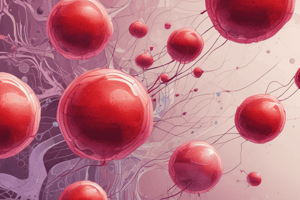Podcast
Questions and Answers
What is the reference range for RDW in newborns?
What is the reference range for RDW in newborns?
What does a wider than normal RBC histogram indicate?
What does a wider than normal RBC histogram indicate?
At what age does RDW typically reach adult levels?
At what age does RDW typically reach adult levels?
Which of the following conditions is associated with increased RDW?
Which of the following conditions is associated with increased RDW?
Signup and view all the answers
What is a characteristic of hypochromic cells?
What is a characteristic of hypochromic cells?
Signup and view all the answers
In which condition might you find both hypochromic and normochromic cells together?
In which condition might you find both hypochromic and normochromic cells together?
Signup and view all the answers
Which grading of hypochromia indicates that the area of central pallor is 1/2 of the diameter?
Which grading of hypochromia indicates that the area of central pallor is 1/2 of the diameter?
Signup and view all the answers
What condition is typically associated with macrocytic MCV?
What condition is typically associated with macrocytic MCV?
Signup and view all the answers
Study Notes
Red Cell Distribution Width (RDW)
- RDW is a measure of variation in red blood cell (RBC) size.
- Reference range for newborns is 14.2 to 19.9%.
- If the RBC histogram is wider than normal, the RDW is abnormal.
- RDW is markedly increased in newborns but gradually decreases to adult levels by 6 months of age.
Red Blood Cell (RBC) Size and RDW
- RBC size can be assessed by Mean Corpuscular Volume (MCV).
-
Decreased (microcytic):
- Anemia of chronic inflammation (ACI)
- Iron deficiency anemia
- Normal (normocytic): G6PD deficiency
-
Increased (macrocytic):
- Liver disease
- Megaloblastic anemia
- Sickle cell anemia
Anisochromia
- General term for variation in RBC coloration.
- Normally, RBCs have a central area of pallor approximately 1/3 the diameter.
- Anisochromia may also mean presence of both hypochromic and normochromic cells in a blood smear.
- Hypochromic cells:
- Central pallor > 1/3 of diameter
- Usually microcytic
- Hypochromic cells may also be seen in sideroblastic anemias, or after a blood transfusion with normal cells and some weeks after iron therapy for iron deficiency anemia.
Grading of Hypochromia
- 1+: Area of central pallor = 1/2
- 2+: Area of central pallor = 2/3
- 3+: Area of central pallor = 3/4
- 4+: Thin rim of hemoglobin
Studying That Suits You
Use AI to generate personalized quizzes and flashcards to suit your learning preferences.
Description
This quiz explores Red Cell Distribution Width (RDW) and its significance in measuring red blood cell size variation. Key concepts include the reference ranges for newborns, how RBC size is assessed, and the implications of anisochromia in blood smears. Test your understanding of these important hematological parameters.




